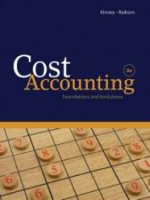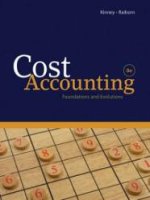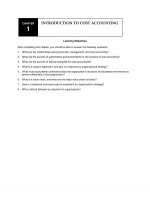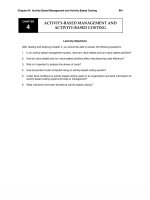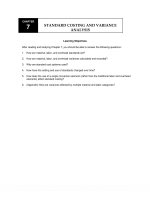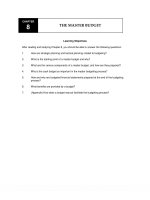Solution manual cost accounting 8th by kinney chapter 06
Bạn đang xem bản rút gọn của tài liệu. Xem và tải ngay bản đầy đủ của tài liệu tại đây (301.04 KB, 19 trang )
To download more slides, ebook, solutions and test bank, visit
CHAPTER
6
PROCESS COSTING
Learning Objectives
After reading and studying Chapter 6, you should be able to answer the following questions:
1. Why are equivalent units of production used in process costing?
2. How are equivalent units of production, unit costs, and inventory values determined using the
weighted average (WA) method of process costing?
3. How are equivalent units of production, unit costs, and inventory values determined using the
first-in, first-out (FIFO) method of process costing?
4. How are transferred-in costs and units accounted for in a multidepartment production setting?
5. How are equivalent units of production, unit costs, and inventory values determined using the
standard costing method of process costing?
6. Why would a company use a hybrid costing system?
7. (Appendix 1) What alternative methods can be used to calculate equivalent units of production?
8. (Appendix 2) How are normal and abnormal spoilage losses treated in an equivalent units of
production (EUP) schedule?
©2011 Cengage Learning. All Rights Reserved. SM Cost Accounting 8th Edition by Raiborn and Kinney.
Visit to download more slides, ebooks, solution manual, and test bank.
To download more slides, ebook, solutions and test bank, visit
Chapter 06: Process Costing
IM 2
Terminology
Continuous loss: a loss that occurs fairly uniformly through the production process
Cost of production report: a process costing document that details all manufacturing quantities and
costs, shows the computation of cost per equivalent unit of production, and indicates the cost assigned to
goods produced during the period
Discrete loss: a loss that is assumed to occur at a specific point and that is detectible only when a
quality check is performed
Equivalent units of production (EUP): approximations of the number of whole units of output that could
have been produced during a period from the actual resources expended during that period; used in
process costing systems to assign costs to production
First-in, first-out (FIFO) method (of process costing): a method that separates beginning work in
process inventory and current period production and their costs so that a current period cost per unit can
be calculated
Hybrid costing system: a costing system that combines characteristics of both job order and process
costing systems
Method of neglect: a method whereby the costs of normal shrinkage and normal continuous losses in a
process costing environment are excluded from the equivalent units schedule thus resulting in a smaller
number of equivalent units of production; dividing production costs by a smaller number of equivalent
units raises the cost per equivalent unit, thus spreading the cost of lost units proportionately over the
good units transferred and those remaining in work in process inventory
Total cost to account for: the sum of the balance in Work in Process Inventory at the beginning of the
period plus all current costs for direct material, direct labor, and overhead
Total units to account for: the total number of units (whole and partial) worked on in the department
during the current period; it is sum of the actual beginning inventory units and the units started during the
current period
Units started and completed: the number of units completed during the period less the units in
beginning inventory
Weighted average (WA) method (of process costing): a method of cost assignment that computes a
single average cost per unit of the combined beginning work in process inventory and current period
production
©2011 Cengage Learning. All Rights Reserved. SM Cost Accounting 8th Edition by Raiborn and Kinney.
Visit to download more slides, ebooks, solution manual, and test bank.
To download more slides, ebook, solutions and test bank, visit
Chapter 06: Process Costing
IM 3
Lecture Outline
A. Introduction
1. General
a. This chapter covers process costing, one of the two prevalent product costing systems found
in practice. In addition to the weighted average and first-in, first-out methods, the chapter
describes standard cost process costing and hybrid systems.
b. Companies choose their product costing system (process or job order) based, in part, on the
nature of the products manufactured and customers served.
c.
i.
Job order costing is appropriate for companies making products or providing services in
limited quantities that conform to customer specifications.
ii.
Process costing is appropriate for companies that manufacture products in a continuous
flow process or in batches of output containing units that are all basically identical (e.g.,
Kellogg’s Rice Krispies)
Both job order costing and process costing accumulate costs by cost component in each
production department. However, the two systems assign costs to departmental output
differently.
i.
In job order costing, costs are assigned to specific jobs and then, if possible, to units
contained within the job.
ii.
Process costing uses an averaging technique to assign costs directly to units produced
during the period.
B. Introduction to Process Costing
1. General
a. Process costing is a method of accumulating and assigning costs to units of production in
companies that make large quantities of homogeneous products such as food products,
bricks, gasoline, candles, and paper.
b. Cost assignment in any production environment is essentially an averaging process. In a
nutshell, the actual unit cost of a product is found by dividing a period’s departmental
production costs by the period’s departmental production quantity, the average being
expressed by the following formula:
Unit cost = Production Costs / Production Quantity
2. Production Costs: The Numerator
a. The numerator in the average product cost fraction is the sum of the actual direct materials
cost, actual direct labor cost, and actual or predetermined overhead cost for the period.
b. Cost accumulation in a process costing system differs from job order costing in two ways:
i.
the quantity of products for which costs are accumulated:
©2011 Cengage Learning. All Rights Reserved. SM Cost Accounting 8th Edition by Raiborn and Kinney.
Visit to download more slides, ebooks, solution manual, and test bank.
To download more slides, ebook, solutions and test bank, visit
Chapter 06: Process Costing
ii.
c.
IM 4
in job order costing, production costs are accumulated for each job or batch where
such jobs or batches usually consist of a small quantity of units;
in process costing, production costs are accumulated for each department or process
by product and usually involves the production of a large quantity of units;
the cost object to which the costs are assigned:
in job order costing the cost object is the job;
in process costing, the costs assignable to each product type are designated and
attached to the specific production runs; then the costs are assigned to the units
worked on during the period.
Text Exhibit 6-1 presents the source documents used to make initial cost assignments to
production departments during the period. Costs are then reassigned at the end of the period
(usually monthly) from the production departments to the units produced.
i.
As in job order costing, direct material and direct labor costs present few problems for
cost accumulation and assignment in a process costing system but overhead costs must
be allocated to output unless such costs are relatively constant and production volume is
relatively steady between periods.
LO.1: Why are equivalent units of production used in process costing?
3. Production Quantity: The Denominator
a. The denominator in the unit cost formula represents total departmental production for the
period.
b. If all units were 100% complete at the end of the period, one would simply count the units to
obtain the denominator.
c.
However, usually partially completed units remain in a department at the end of the period.
These units become beginning inventory for the next accounting period. This production
sequence is illustrated in text Exhibit 6-2.
i.
A two-period production sequence means that some costs for the units in beginning
inventory were incurred last period and additional costs for those units will be incurred in
the current period.
ii.
Likewise, some costs will be incurred this period on units in ending inventory and more
costs will be incurred on those units during the following period.
d. Process costing assigns costs to both fully and partially completed units by mathematically
converting partially completed units into equivalent whole units.
4. Equivalent units of production (EUP) are an approximation of the number of whole units of
output that could have been produced during a period from the actual resources expended during
that period.
©2011 Cengage Learning. All Rights Reserved. SM Cost Accounting 8th Edition by Raiborn and Kinney.
Visit to download more slides, ebooks, solution manual, and test bank.
To download more slides, ebook, solutions and test bank, visit
Chapter 06: Process Costing
IM 5
a. The following example illustrates the computation of equivalent units of production when
there is no beginning inventory:
A department worked on 220,000 units in November. 200,000 units were completed and
20,000 units were 40% complete at the end of the period
EUP = 200,000 completed units + (20,000 x 40%) = 208,000
b. Separate EUP calculations must be made for each cost component as illustrated in text
Exhibit 6-3.
i.
Some direct material must be introduced at the start of a production process or there
would be no need for labor or overhead to be incurred. The beginning material is one
hundred percent complete throughout the process regardless of the percentage of
completion of labor and overhead.
ii.
Additional materials may be added at any point during processing, or continuously during
processing, or even at the end of processing.
iii. One percentage of completion estimate may be made and used for conversion costs
(direct labor and overhead) if overhead is applied on a direct labor basis, or direct labor
and overhead are added to the product at the same rate.
However, the increased use of multiple cost pools and/or activity-based costing
concepts makes it less likely that the degrees of completion for direct labor and
overhead will be equal. Thus, separate EUP computations for direct labor and
overhead will be increasingly common.
C. Weighted Average and First-in, First-out Process Costing Methods
1. General
a. The weighted average method is a method of computing production quantity (the
denominator) in a process costing system that focuses on the total work done to date.
i.
The weighted average method focuses on the units that are completed in the current
period and the units remaining in ending inventory.
ii.
The weighted average method is not concerned with when the work on completed units
was performed (whether in the prior period or in the current period).
iii. Thus, the weighted average method does not distinguish between units started last
period but finished this period and those that were both started and finished this period.
b. The FIFO method is a method of computing production quantity (the denominator) in a
process costing system that computes an average cost per equivalent unit of production
using only current period production and cost information.
i.
The FIFO method separates beginning inventory and current period production and their
costs so that a current period cost per unit can be calculated.
ii.
The FIFO method more realistically reflects the way in which most goods actually flow
through the production system.
©2011 Cengage Learning. All Rights Reserved. SM Cost Accounting 8th Edition by Raiborn and Kinney.
Visit to download more slides, ebooks, solution manual, and test bank.
To download more slides, ebook, solutions and test bank, visit
Chapter 06: Process Costing
IM 6
iii. The FIFO method does not commingle units and costs of different periods, so that
equivalent units and costs of beginning inventory are withheld from the computation of
average current period cost. The focus is specifically on the work performed during the
current period, and the EUP schedule shows only that work.
c.
The only difference between the calculations under the two methods is that the work
performed in the prior period on beginning inventory is included in the current period using
WA but is not included in the current period EUP using FIFO.
2. One purpose of any costing system is the determination of a product cost for use on financial
statements.
a. Costs must be assigned to goods transferred from WIP to Finished Goods Inventory (or to
another department).
b. In addition, at the end of any period, a value must be assigned to goods still in WIP.
3. General approach to process costing
a. Text Exhibit 6-4 outlines the six general steps in a process costing system.
i.
Step 1: Calculate the physical units to account for;
ii.
Step 2: Calculate the physical units accounted for (verify that step 1 equals step 2);
iii. Step 3: Calculate the equivalent units of production;
iv. Step 4: Calculate the total cost to account for;
v.
Step 5: Calculate the cost per equivalent unit of production; and
vi. Step 6: Assign the costs to inventory accounts (verify that the total costs transferred out
plus the costs in ending inventory (step 6) equal the costs determined in step 4).
b. The total cost to account for is the sum of the balance in WIP at the beginning of the period
plus all current period costs for direct material, direct labor, and overhead.
c.
An example is used to demonstrate the steps involved in the computation of EUP and cost
assignment for both the WA and FIFO methods.
i.
Text Exhibit 6-5 presents information for the April 2010 production activity of a candle
maker.
LO.2: How are equivalent units of production, unit costs, and inventory values determined using
the weighted average method of process costing?
4. Weighted Average Method
a. Step 1: Calculate the total physical units to account for.
©2011 Cengage Learning. All Rights Reserved. SM Cost Accounting 8th Edition by Raiborn and Kinney.
Visit to download more slides, ebooks, solution manual, and test bank.
To download more slides, ebook, solutions and test bank, visit
Chapter 06: Process Costing
i.
IM 7
The total units to account for are the sum of whole and partial units worked on in the
department during the current period. It is equal to actual beginning inventory units plus
actual units started.
There were 10,000 units in beginning work in process inventory and 401,400 candles
were started during the current period, giving total units to account for of 411,400
candles.
b. Step 2: Calculate the physical units accounted for.
i.
Units were either completed and transferred out or remain (partially completed) in ending
WIP.
c.
406,000 candles were completed and transferred out while 5,400 partially completed
candles remain in ending inventory, resulting in total units accounted for of 411,400
candles.
Step 3: Calculate the Equivalent Units of Production (EUP) using the weighted average
method.
i.
The units started and completed equal the difference between the number of units
completed for the period and the units in beginning inventory; it can also be computed as
the number of units started during the period minus the units in ending inventory.
ii.
406,000 candles were completed and transferred out less the 10,000 units in
beginning inventory equals 396,000 candles started and completed.
Text Exhibit 6-6 illustrates the concepts of total units to account for, total units accounted
for, and units started and completed during the period.
iii. Two sets of EUPs are computed: Direct materials and Conversion (Labor and overhead).
All DM is added at the be��������������������������������������������������������������������������������������������������������������������������������������������������������������������������������������������������������������������������������������������������������������������������������������������������������������������������������������������������������������������������������������������������������������������������������������������������������������������������������������������������������������������������������������������������������������������������������������������������������������������������������������������������������������������������������������������������������������������������������������������������������������������������������������������������������������������������������������������������������������������������������������������������������������������������������������������������������������������������������������������������������������������������������������������������������������������������������������������������������������������������������������������������������������������������������������������������������������������������������������������������������������������������������������������������������������������������������������������������������������������������������������������������������������������������������������������������������������������������������������������������������������������������������������������������������������������������������������������������������������������������������������������������������������������������������������������������������������������������������������������������������������������������������������������������������������������������������������������������������������������������������������������������������������������������������������������������������������������������������������������������������������������������������������������������������������������������������������������������������������������������������������������������������������������������������������������������������������������������������������������������������������������������������������������������������������������������������������������������������������������������������������������������������������������������������������������������������������������������������������������������������������������������������������������������������������������������������������������������������������������������������������������������������������������������������������������������������������������������������������������������������������������������������������������������������������������������������������������������������������������������������������������������������������������������������������������������������������������������������������������������������������������������������������������������������������������������������������������������������������������������������������������������������������������������������������������������������������������������������������������������������������������������������������������������������������������������������������������������������������������������������������������������������������������������������������������������������������������������������������������������������������������������������������������������������������������������������������������������������������������������������������������������������������������������������������������������������������������������������������������������������������������������������������������������������������������������������������������������������������������������������������������������������������������������������������������������������������������������������������������������������������������������������������������������������������������������������������������������������������������������������������������������������������������������������������������������������������������������������������������������������������������������������������������������������������������������������������������������������������������������������������������������������������������������������������������������������������������������������������������������������������������������������������������������������������������������������������������������������������������������������������������������������������������������������������������������������������������������������������������������������������������������������������������������������������������������������������������������������������������������������������������������������������������������������������������������������������������������������������������������������������������������������������������������������������������������������������������������������������������������������������������������������������������������������������������������������������������������������������������������������������������������������������������������������������������������������������������������������������������������������������������������������������������������������������������������������������������������������������������������������������������������������������������������������������������������������������������������������������������������������������������������������������������������������������������������������������������������������������������������������������������������������������������������������������������������������������������������������������������������������������������������������������������������������������������������������������������������������������������������������������������������������������������������������������������������������������������������������������������������������������������������������������������������������������������������������������������������������������������������������������������������������������������������������������������������������������������������������������������������������������������������������������������������������������������������������������������������������������������������������������������������������������������������������������������������������������������������������������������������������������������������������������������������������������������������������������������������������������������������������������������������������������������������������������������������������������������������������������������������������������������������������������������������������������������������������������������������������������������������������������������������������������������������������������������������������������������������������������������������������������������������������������������������������������������������������������������������������������������������������������������������������������������������������������������������������������������������������������������������������������������������������������������������������������������������������������������������������������������������������������������������������������������������������������������������������������������������������������������������������������������������������������������������������������������������������������������������������������������������������������������������������������������������������������������������������������������������������������������������������������������������������������������������������������������������������������������������������������������������������������������������������������������������������������������������������������������������������������������������������������������������������������������������������������������������������������������������������������������������������������������������������������������������������������������������������������������������������������������������������������������������������������������������������������������������������������������������������������������������������������������������������y as the other cost categories (DM and Conversion).
©2011 Cengage Learning. All Rights Reserved. SM Cost Accounting 8th Edition by Raiborn and Kinney.
Visit to download more slides, ebooks, solution manual, and test bank.
To download more slides, ebook, solutions and test bank, visit
Chapter 06: Process Costing
IM 11
2. A successor department may or may not add additional raw materials to the units that were
transferred in or may provide additional labor with a corresponding incurrence of overhead.
3. Successor departments may change the unit of measure from that of predecessor departments.
4. An example of a multidepartment application is provided in the demonstration problem at the end
of the chapter.
LO.5: How are equivalent units of production, unit costs, and inventory values determined using
the standard costing method of process costing?
E. Process Costing with Standard Costs
1. Standard costing eliminates the periodic re-computation of production cost that is required under
actual costing.
2. Equivalent unit calculations for standard process costing are identical to those of FIFO process
costing.
3. Standard cost usage simplifies process costing and allows variances to be measured during the
period.
4. The standard costs for the candle product discussed earlier are provided in text Exhibit 6-10
along with the FIFO EUP calculations.
5. Text Exhibit 6-11 presents the cost of production report using standard cost information.
6. Summary journal entries are also provided in the text.
LO.6: Why would a company use a hybrid costing system?
F. Hybrid Costing Systems
1. Job order and process costing systems are two ends of a continuum.
2. A hybrid costing system is a costing system that combines certain characteristics of both job
order and process costing.
a. For example, a hybrid system might be used in a manufacturing environment in which various
product lines have different direct materials, but similar processing techniques.
i.
In that case, the company could use job order techniques to trace the direct material
costs and process costing techniques to account for the conversion costs.
3. Hybrid systems can provide a more accurate accounting picture of the actual type of
manufacturing activities in companies that use flexible manufacturing processes.
a. As the use of flexible manufacturing increases, so will the use of hybrid costing systems.
©2011 Cengage Learning. All Rights Reserved. SM Cost Accounting 8th Edition by Raiborn and Kinney.
Visit to download more slides, ebooks, solution manual, and test bank.
To download more slides, ebook, solutions and test bank, visit
Chapter 06: Process Costing
IM 12
LO.7: (Appendix 1) What alternative methods can be used to calculate equivalent units of
production?
G. Alternative Calculations of Weighted Average and FIFO Methods
1. Weighted average EUP may be calculated as follows:
Units transferred out (whole units)
+ Ending WIP (equivalent units)
Weighted average EUP
2. FIFO EUP may be calculated as follows:
Weighted average EUP
- Beginning WIP (equivalent units)
FIFO EUP
The EUP calculations for both the weighted average and FIFO methods under this alternative
approach for the Colorful Candle Company are provided in the appendix.
3. The distinct relationship between the WA and FIFO methods can also be used in another manner
to generate EUPs:
a. Weighted average method:
Total units to account for
- EUP to be completed in the next period (EI x % NOT completed)
Weighted average EUP
b. Alternatively, EUP under the FIFO method may be calculated as follows:
Weighted average EUP
- EUP completed in the prior period (BI x % completed last period)
FIFO EUP
c.
These EUP calculations for both the weighted average and FIFO methods for the candle
company example are also provided in the appendix.
LO.8: (Appendix 2) How are normal and abnormal spoilage losses treated in an EUP schedule?
H. Spoilage
1. Spoilage represents units from the production process that fail to meet specifications.
2. Losses in a production process may occur continuously or at a specific point in the production
process.
a. Continuous loss: losses in a production process that occur fairly uniformly through the
process.
b. Discrete loss: a loss that occurs at a specific point in the production process.
©2011 Cengage Learning. All Rights Reserved. SM Cost Accounting 8th Edition by Raiborn and Kinney.
Visit to download more slides, ebooks, solution manual, and test bank.
To download more slides, ebook, solutions and test bank, visit
Chapter 06: Process Costing
IM 13
3. Several methods may be used to account for units lost during production.
a. Text Exhibit 6-12 summarizes the accounting for the cost of lost units.
b. Normal continuous losses
i.
The costs of normal shrinkage and normal continuous losses are handled through the
method of neglect, which excludes the spoiled units from EUP.
ii.
c.
This results in smaller EUP and raises the cost per equivalent unit. Therefore, the
cost of the normal spoilage is spread proportionately over good units transferred and
those remaining in WIP.
The cost of normal continuous losses is a product cost.
Normal discrete losses
i.
The cost of normal discrete losses are assigned only to units that have passed the
inspection point because assigning loss costs to units that may be found to be defective
in the next period would not be reasonable.
ii.
The cost of normal discrete losses is a product cost.
d. Abnormal losses
i.
Abnormal losses, both continuous and discrete, are expensed in the current period.
e. Text Exhibit 6-13, provides production cost data for Hanks Inc. which is used to illustrate the
method of neglect for a normal loss and an abnormal loss.
i.
Text Exhibit 6-14 presents the cost of production report. Note that the normal spoilage
of 4,500 units is omitted from the EUP calculation, increasing cost per equivalent units,
and thus spreading the cost proportionately over good units transferred and ending WIP.
ii.
The abnormal spoilage of 3,300 units is included in the EUP calculation but is expensed
in the current period (refer to the Cost Assignment panel of the Cost of Production Report
in Exhibit 6-14).
©2011 Cengage Learning. All Rights Reserved. SM Cost Accounting 8th Edition by Raiborn and Kinney.
Visit to download more slides, ebooks, solution manual, and test bank.
To download more slides, ebook, solutions and test bank, visit
Chapter 06: Process Costing
IM 14
Multiple Choice Questions
1. (LO.1) Which of the following would least likely use a process costing system?
a. Manufacturer of custom furniture
b. Manufacturer of soft drinks
c. Manufacturer of gasoline
d. Manufacturer of paper
2. (LO.1) Which of the following is not a basic objective of process costing?
a. Compute an average cost per unit since units are homogeneous
b. Allocate production costs between whole units and partial units
c. Separate production costs into fixed and variable components
d. Determine the amount of production costs that should be transferred to the next department
3. (LO.1) Select the incorrect statement regarding equivalent units of production (EUP).
a. Two units 50% complete are equivalent to one unit 100% complete.
b. Except in very rare instances, only one EUP calculation is needed per department.
c. EUP equals the number of whole units of output that could have been produced during a
period from the actual effort expended.
d. The objective of EUP calculations is to eliminate the costing problem caused by partially
completed units.
4. (LO.2) The steps in process costing are listed below:
1 – Calculate physical units to be accounted for
2 – Calculate physical units accounted for
3 – Calculate equivalent units of production (EUP)
4 – Calculate total costs to be accounted for
5 – Calculate the cost per EUP
6-?
What is the missing step?
a. Assign costs to whole and partial units in ending inventory
b. Assign costs to whole units produced during the period
c. Assign costs to units started and completed during the period
d. Assign costs to units transferred out and units in ending inventory
5. (LO.2) Which of the following is true about the weighted average method of process costing?
a. The calculation of EUP must take into consideration the units in both beginning and ending
inventory.
b. The cost per EUP will include prior period costs if the department had beginning inventory.
c. The most common alternative to the weighted average method is the last-in, first-out method.
d. The weighted average method refers to a method of determining which units were sold and
which units remain in inventory.
©2011 Cengage Learning. All Rights Reserved. SM Cost Accounting 8th Edition by Raiborn and Kinney.
Visit to download more slides, ebooks, solution manual, and test bank.
To download more slides, ebook, solutions and test bank, visit
Chapter 06: Process Costing
IM 15
Use the following information for the next three questions.
Z Company employs a process costing system for its manufacturing operations. All direct
materials are added at the beginning of the process and conversion costs are added
proportionately. The production quantity schedule for April is reproduced below:
Work in process on April 1 (60% complete as to conversion costs)
Units started during April
Total units to account for
Units
1,000
5,000
6,000
Units completed and transferred out
Work in process on April 30 (20% complete as to conversion costs)
Total units accounted for
4,000
2,000
6,000
Costs pertaining to the month of April are as follows:
Beginning inventory costs: (DM, $54,600; Conversion, $35,560)
Costs incurred during April (DM, $468,000; Conversion $574,060)
$ 90,160
$1,042,060
6. (LO.2) Using the weighted average method, the equivalent units for direct materials for April
are:
a. 6,000 units.
b. 5,000 units.
c. 4,400 units.
d. 3,800 units.
7. (LO.2) Using the weighted average method, the equivalent units for conversion costs for April
are:
a. 6,000 units.
b. 5,000 units.
c. 4,400 units.
d. 3,800 units.
8. (LO.2) Using the weighted average method, the equivalent unit materials cost for April is:
a. $78.00.
b. $87.10.
c. $130.65.
d. $138.55.
9. (LO.2) Using the weighted average method, the 4,000 units completed during April will be
transferred out at an EUP unit cost of:
a. $188.69.
b. $225.65.
c. $257.31.
d. $283.04.
©2011 Cengage Learning. All Rights Reserved. SM Cost Accounting 8th Edition by Raiborn and Kinney.
Visit to download more slides, ebooks, solution manual, and test bank.
To download more slides, ebook, solutions and test bank, visit
Chapter 06: Process Costing
IM 16
Use the following information for the next two questions.
L Company uses a process cost system to account for its manufacturing operations. All direct
materials are added at the beginning of the process and conversion costs are added
proportionately. The production quantity schedule for June is reproduced below:
Work in process on June 1 (20% complete as to conversion costs)
Units started during June
Total units to account for
Units
16,000
100,000
116,000
Units completed and transferred out from beginning inventory
Units started and completed during June
Work in process on June 30 (40% complete as to conversion costs)
Total units accounted for
16,000
76,000
24,000
116,000
Costs pertaining to the month of June are as follows:
Beginning inventory costs: (DM, $54,600; Conversion, $35,560)
Costs incurred during June (DM, $468,000; Conversion $574,060)
$ 90,160
$1,042,060
10. (LO.3) Using the FIFO method, the equivalent units for direct materials for June are:
a. 116,000 units.
b. 100,000 units.
c. 85,600 units.
d. 76,000 units.
11. (LO.3) Using the FIFO method, the equivalent units for conversion costs for June are:
a. 116,000 units.
b. 100,000 units.
c. 98,400 units.
d. 76,000 units.
12. (LO.3) Using the FIFO method, the direct materials cost per equivalent unit for units started and
completed during June is:
a. $6.16.
b. $6.00.
c. $5.23.
d. $4.68.
13. (LO.4) Select the incorrect statement concerning process costing in a multidepartment setting.
a. In this environment, goods are transferred from a predecessor (upstream) department to a
successor (downstream) department.
b. Transferred out costs of the predecessor department become transferred in costs of the
successor department.
c. Occasionally, successor departments will change the unit of measure used in predecessor
departments.
d. By definition, successor departments may not add any additional raw materials to the units
received from predecessor departments.
14. (LO.5) Which of the following statements is true concerning process costing?
a. Companies my substitute standard costs for actual costs.
b. EUP calculations for standard process costing are identical to those of FIFO process costing.
c. An advantage of standard process costing is that material, labor, and overhead variances can
be computed to assist in performance evaluation.
d. All of the above are true.
©2011 Cengage Learning. All Rights Reserved. SM Cost Accounting 8th Edition by Raiborn and Kinney.
Visit to download more slides, ebooks, solution manual, and test bank.
To download more slides, ebook, solutions and test bank, visit
Chapter 06: Process Costing
IM 17
15. (LO.6) An appropriate costing system for a company whose various product lines have different
direct materials but similar processing techniques is likely a
a. weighted average method of process costing.
b. first-in, first out method of process costing.
c. hybrid method of process costing.
d. last-in, first out method of process costing.
16. (LO.7: Appendix 1) Which of the following is a common variation of the weighted average EUP
calculation presented in the chapter?
a. Whole units transferred out + Ending inventory EUP
b. Weighted average EUP – Beginning inventory EUP
c. FIFO EUP / 2
d. Whole units transferred out – Beginning units
17. (LO.8: Appendix 2) In process costing, the cost of normal continuous losses is handled through
the method of neglect, which
a. excludes the spoiled units from the equivalent unit computation, thereby increasing the cost
per equivalent unit.
b. includes the spoiled units in the equivalent unit computation, thereby increasing the cost per
equivalent unit.
c. excludes the spoiled units from the equivalent unit computation, thereby decreasing the cost
per equivalent unit.
d. includes the spoiled units in the equivalent unit computation, thereby decreasing the cost per
equivalent unit.
©2011 Cengage Learning. All Rights Reserved. SM Cost Accounting 8th Edition by Raiborn and Kinney.
Visit to download more slides, ebooks, solution manual, and test bank.
To download more slides, ebook, solutions and test bank, visit
Chapter 06: Process Costing
IM 18
Multiple Choice Solutions
1.
a
2.
c
3.
b
4.
d
5.
b
6.
a (CMA Adapted)
Materials:
Beginning inventory
Started and completed
Ending inventory
Totals
7.
EUPs
1,000
3,000
2,000
6,000
Units
1,000
3,000
2,000
6,000
× 100% =
× 100% =
× 20% =
EUPs
1,000
3,000
400
4,400
b (CMA Adapted)
Material EUP Cost:
Beginning inventory
Added during April
Total materials cost to date
Divide by EUP
Equivalent unit conversion cost
9.
× 100% =
× 100% =
× 100% =
c (CMA Adapted)
Conversion:
Beginning inventory
Started and completed
Ending inventory
Totals
8.
Units
1,000
3,000
2,000
6,000
Material
$ 54,600
468,000
$522,600
6,000
$ 87.10
Conversion
$ 35,560
574,060
$609,620
4,400
$ 138.55
b (CMA Adapted)
$87.10 + 138.55 = $225.65
10.
b (CMA Adapted)
Materials:
Beginning inventory
Started and completed
Ending inventory
Totals
Units
16,000
76,000
24,000
116,000
×
0% =
× 100% =
× 100% =
EUPs
0
76,000
24,000
100,000
©2011 Cengage Learning. All Rights Reserved. SM Cost Accounting 8th Edition by Raiborn and Kinney.
Visit to download more slides, ebooks, solution manual, and test bank.
To download more slides, ebook, solutions and test bank, visit
Chapter 06: Process Costing
11.
c (CMA Adapted)
Conversion:
Beginning inventory
Started and completed
Ending inventory
Totals
12.
IM 19
Units
16,000
76,000
24,000
116,000
× 80% =
× 100% =
× 40% =
EUPs
12,800
76,000
9,600
98,400
d (CMA Adapted)
Added during period
Total materials
Divide by EUP
Equivalent unit conversion cost
13.
d
14.
d
15.
c
16.
a
17.
a
Material
468,000
$468,000
100,000
$
4.68
©2011 Cengage Learning. All Rights Reserved. SM Cost Accounting 8th Edition by Raiborn and Kinney.
Visit to download more slides, ebooks, solution manual, and test bank.
